Report on Entrepreneurial Opportunities: Market Gap Analysis
VerifiedAdded on 2023/01/23
|15
|4268
|22
Report
AI Summary
This report presents an analysis of entrepreneurial opportunities within the context of establishing a museum bar. It begins by defining entrepreneurial opportunities and then evaluates various sources of business ideas and innovation, referencing Drucker's 7 sources of change and the STEEP model. The report then focuses on identifying market gaps using tools like STP (segmentation, targeting, and positioning) and Porter's 5 Forces to assess the industry environment. It further details the data required to support gap analysis, explaining the use of primary and secondary research methods, including surveys and online research. The interpretation of data to provide evidence of market potential is discussed. The report concludes with a SWOT analysis and an evaluation of the competitive and market environments, offering a comprehensive overview of the factors influencing the success of the proposed museum bar business.
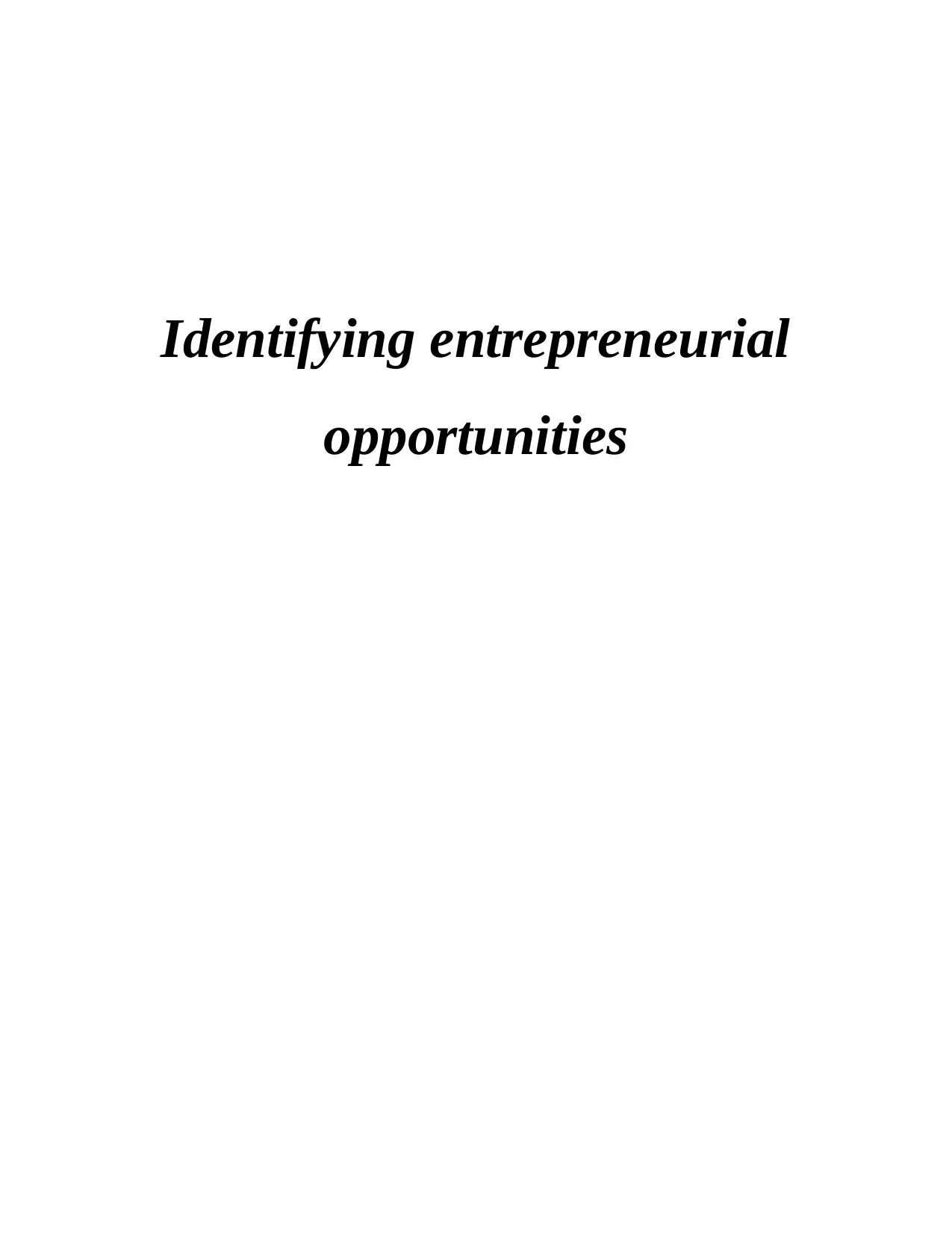
Identifying entrepreneurial
opportunities
opportunities
Paraphrase This Document
Need a fresh take? Get an instant paraphrase of this document with our AI Paraphraser
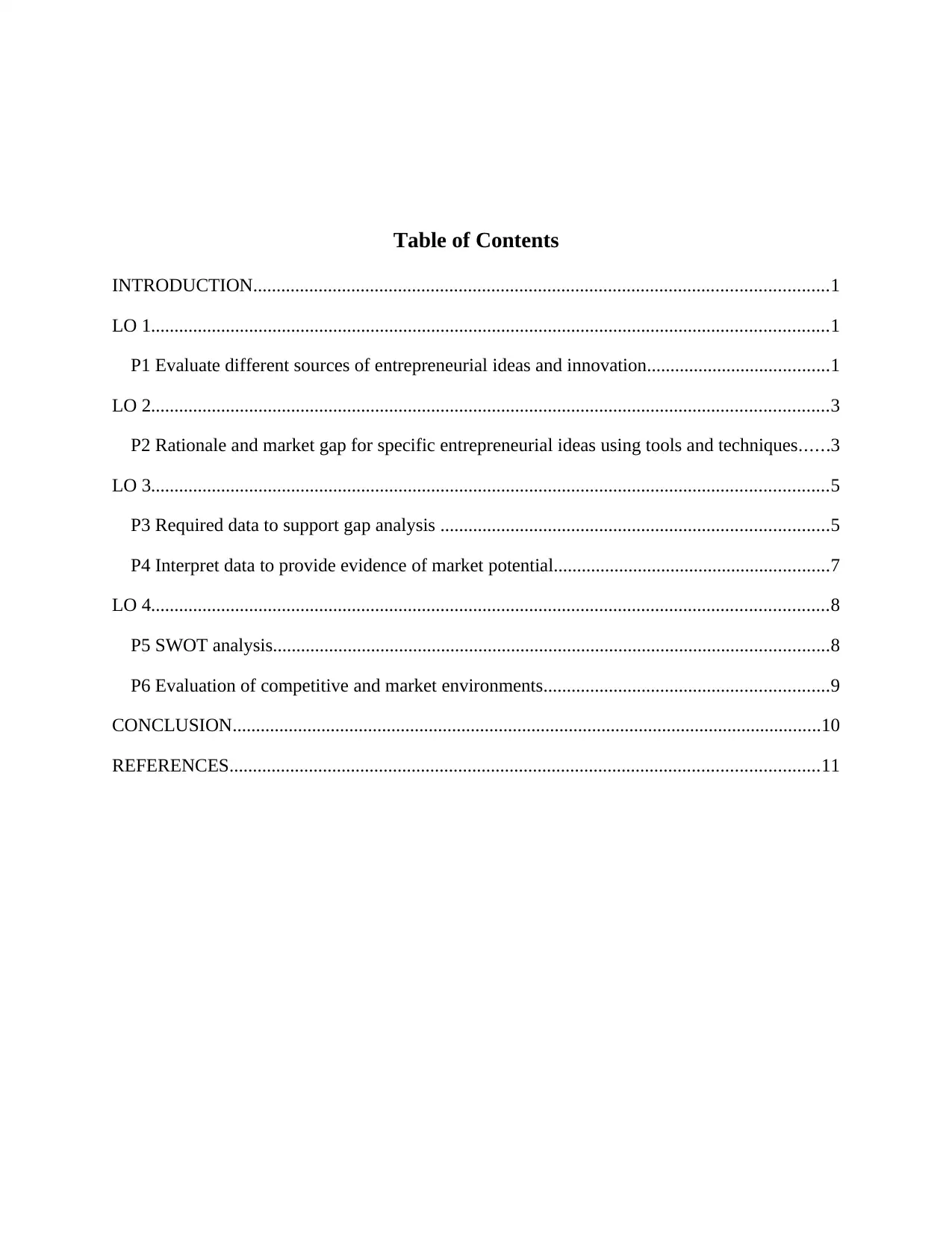
Table of Contents
INTRODUCTION...........................................................................................................................1
LO 1.................................................................................................................................................1
P1 Evaluate different sources of entrepreneurial ideas and innovation.......................................1
LO 2.................................................................................................................................................3
P2 Rationale and market gap for specific entrepreneurial ideas using tools and techniques......3
LO 3.................................................................................................................................................5
P3 Required data to support gap analysis ...................................................................................5
P4 Interpret data to provide evidence of market potential...........................................................7
LO 4.................................................................................................................................................8
P5 SWOT analysis.......................................................................................................................8
P6 Evaluation of competitive and market environments.............................................................9
CONCLUSION..............................................................................................................................10
REFERENCES..............................................................................................................................11
INTRODUCTION...........................................................................................................................1
LO 1.................................................................................................................................................1
P1 Evaluate different sources of entrepreneurial ideas and innovation.......................................1
LO 2.................................................................................................................................................3
P2 Rationale and market gap for specific entrepreneurial ideas using tools and techniques......3
LO 3.................................................................................................................................................5
P3 Required data to support gap analysis ...................................................................................5
P4 Interpret data to provide evidence of market potential...........................................................7
LO 4.................................................................................................................................................8
P5 SWOT analysis.......................................................................................................................8
P6 Evaluation of competitive and market environments.............................................................9
CONCLUSION..............................................................................................................................10
REFERENCES..............................................................................................................................11
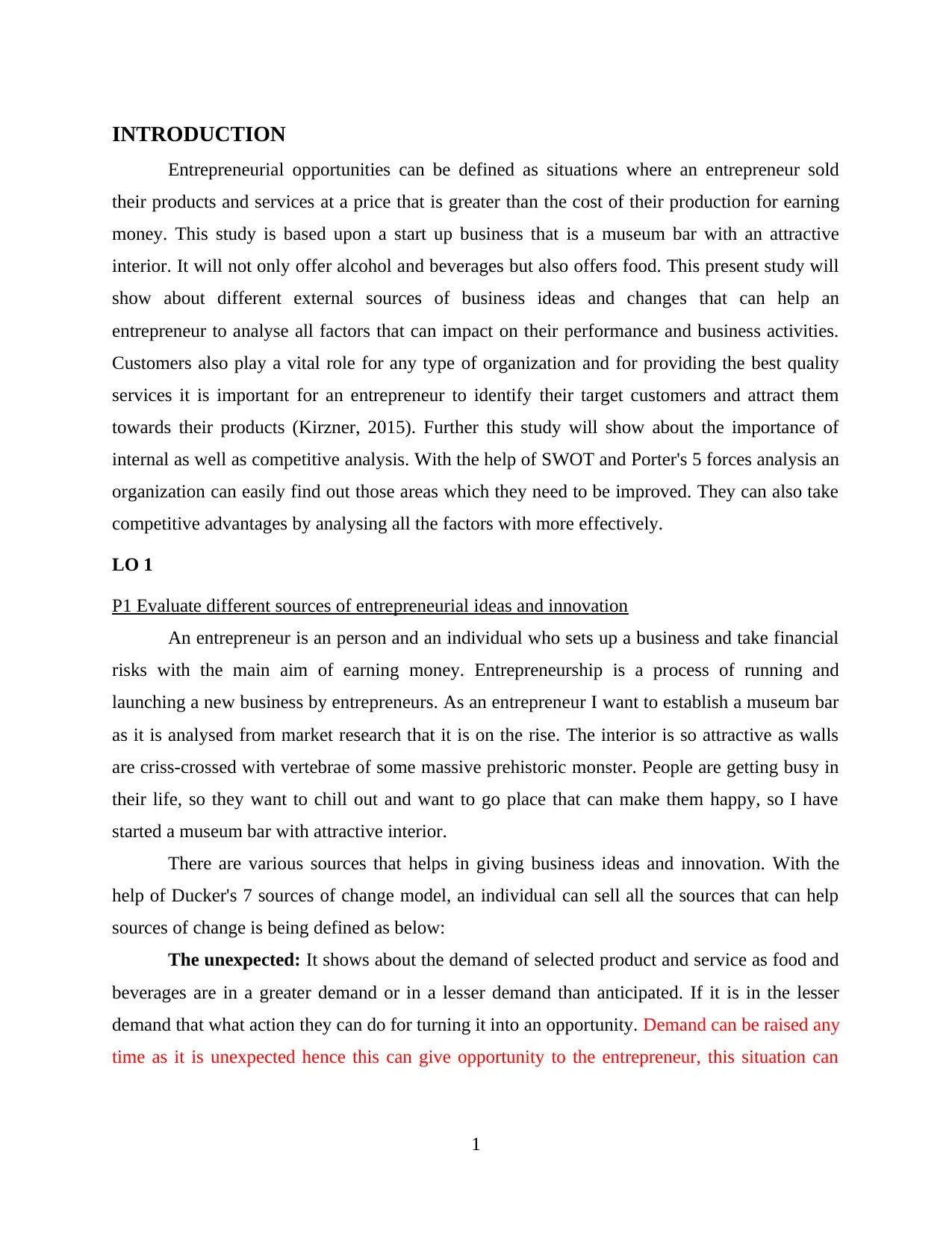
INTRODUCTION
Entrepreneurial opportunities can be defined as situations where an entrepreneur sold
their products and services at a price that is greater than the cost of their production for earning
money. This study is based upon a start up business that is a museum bar with an attractive
interior. It will not only offer alcohol and beverages but also offers food. This present study will
show about different external sources of business ideas and changes that can help an
entrepreneur to analyse all factors that can impact on their performance and business activities.
Customers also play a vital role for any type of organization and for providing the best quality
services it is important for an entrepreneur to identify their target customers and attract them
towards their products (Kirzner, 2015). Further this study will show about the importance of
internal as well as competitive analysis. With the help of SWOT and Porter's 5 forces analysis an
organization can easily find out those areas which they need to be improved. They can also take
competitive advantages by analysing all the factors with more effectively.
LO 1
P1 Evaluate different sources of entrepreneurial ideas and innovation
An entrepreneur is an person and an individual who sets up a business and take financial
risks with the main aim of earning money. Entrepreneurship is a process of running and
launching a new business by entrepreneurs. As an entrepreneur I want to establish a museum bar
as it is analysed from market research that it is on the rise. The interior is so attractive as walls
are criss-crossed with vertebrae of some massive prehistoric monster. People are getting busy in
their life, so they want to chill out and want to go place that can make them happy, so I have
started a museum bar with attractive interior.
There are various sources that helps in giving business ideas and innovation. With the
help of Ducker's 7 sources of change model, an individual can sell all the sources that can help
sources of change is being defined as below:
The unexpected: It shows about the demand of selected product and service as food and
beverages are in a greater demand or in a lesser demand than anticipated. If it is in the lesser
demand that what action they can do for turning it into an opportunity. Demand can be raised any
time as it is unexpected hence this can give opportunity to the entrepreneur, this situation can
1
Entrepreneurial opportunities can be defined as situations where an entrepreneur sold
their products and services at a price that is greater than the cost of their production for earning
money. This study is based upon a start up business that is a museum bar with an attractive
interior. It will not only offer alcohol and beverages but also offers food. This present study will
show about different external sources of business ideas and changes that can help an
entrepreneur to analyse all factors that can impact on their performance and business activities.
Customers also play a vital role for any type of organization and for providing the best quality
services it is important for an entrepreneur to identify their target customers and attract them
towards their products (Kirzner, 2015). Further this study will show about the importance of
internal as well as competitive analysis. With the help of SWOT and Porter's 5 forces analysis an
organization can easily find out those areas which they need to be improved. They can also take
competitive advantages by analysing all the factors with more effectively.
LO 1
P1 Evaluate different sources of entrepreneurial ideas and innovation
An entrepreneur is an person and an individual who sets up a business and take financial
risks with the main aim of earning money. Entrepreneurship is a process of running and
launching a new business by entrepreneurs. As an entrepreneur I want to establish a museum bar
as it is analysed from market research that it is on the rise. The interior is so attractive as walls
are criss-crossed with vertebrae of some massive prehistoric monster. People are getting busy in
their life, so they want to chill out and want to go place that can make them happy, so I have
started a museum bar with attractive interior.
There are various sources that helps in giving business ideas and innovation. With the
help of Ducker's 7 sources of change model, an individual can sell all the sources that can help
sources of change is being defined as below:
The unexpected: It shows about the demand of selected product and service as food and
beverages are in a greater demand or in a lesser demand than anticipated. If it is in the lesser
demand that what action they can do for turning it into an opportunity. Demand can be raised any
time as it is unexpected hence this can give opportunity to the entrepreneur, this situation can
1
⊘ This is a preview!⊘
Do you want full access?
Subscribe today to unlock all pages.

Trusted by 1+ million students worldwide
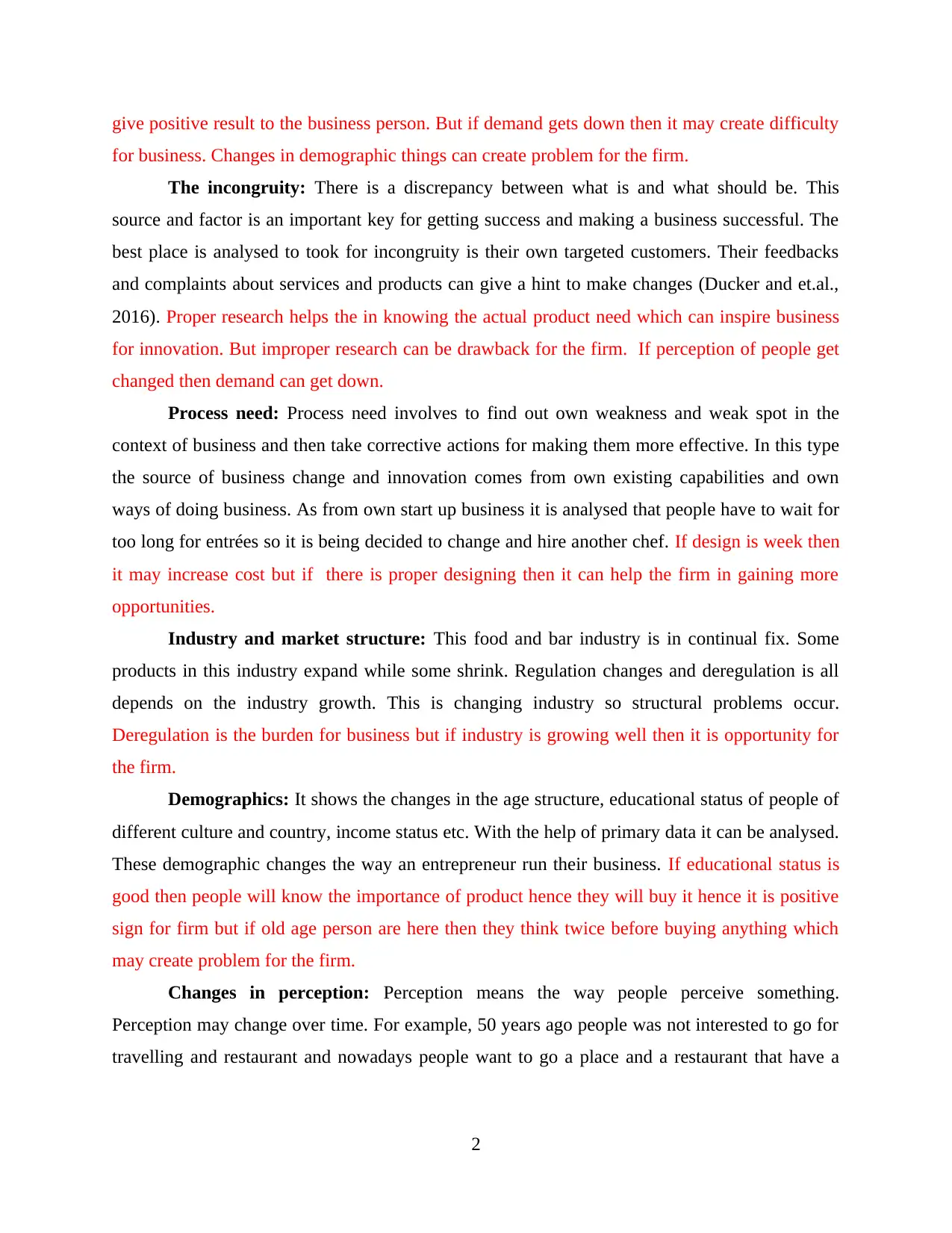
give positive result to the business person. But if demand gets down then it may create difficulty
for business. Changes in demographic things can create problem for the firm.
The incongruity: There is a discrepancy between what is and what should be. This
source and factor is an important key for getting success and making a business successful. The
best place is analysed to took for incongruity is their own targeted customers. Their feedbacks
and complaints about services and products can give a hint to make changes (Ducker and et.al.,
2016). Proper research helps the in knowing the actual product need which can inspire business
for innovation. But improper research can be drawback for the firm. If perception of people get
changed then demand can get down.
Process need: Process need involves to find out own weakness and weak spot in the
context of business and then take corrective actions for making them more effective. In this type
the source of business change and innovation comes from own existing capabilities and own
ways of doing business. As from own start up business it is analysed that people have to wait for
too long for entrées so it is being decided to change and hire another chef. If design is week then
it may increase cost but if there is proper designing then it can help the firm in gaining more
opportunities.
Industry and market structure: This food and bar industry is in continual fix. Some
products in this industry expand while some shrink. Regulation changes and deregulation is all
depends on the industry growth. This is changing industry so structural problems occur.
Deregulation is the burden for business but if industry is growing well then it is opportunity for
the firm.
Demographics: It shows the changes in the age structure, educational status of people of
different culture and country, income status etc. With the help of primary data it can be analysed.
These demographic changes the way an entrepreneur run their business. If educational status is
good then people will know the importance of product hence they will buy it hence it is positive
sign for firm but if old age person are here then they think twice before buying anything which
may create problem for the firm.
Changes in perception: Perception means the way people perceive something.
Perception may change over time. For example, 50 years ago people was not interested to go for
travelling and restaurant and nowadays people want to go a place and a restaurant that have a
2
for business. Changes in demographic things can create problem for the firm.
The incongruity: There is a discrepancy between what is and what should be. This
source and factor is an important key for getting success and making a business successful. The
best place is analysed to took for incongruity is their own targeted customers. Their feedbacks
and complaints about services and products can give a hint to make changes (Ducker and et.al.,
2016). Proper research helps the in knowing the actual product need which can inspire business
for innovation. But improper research can be drawback for the firm. If perception of people get
changed then demand can get down.
Process need: Process need involves to find out own weakness and weak spot in the
context of business and then take corrective actions for making them more effective. In this type
the source of business change and innovation comes from own existing capabilities and own
ways of doing business. As from own start up business it is analysed that people have to wait for
too long for entrées so it is being decided to change and hire another chef. If design is week then
it may increase cost but if there is proper designing then it can help the firm in gaining more
opportunities.
Industry and market structure: This food and bar industry is in continual fix. Some
products in this industry expand while some shrink. Regulation changes and deregulation is all
depends on the industry growth. This is changing industry so structural problems occur.
Deregulation is the burden for business but if industry is growing well then it is opportunity for
the firm.
Demographics: It shows the changes in the age structure, educational status of people of
different culture and country, income status etc. With the help of primary data it can be analysed.
These demographic changes the way an entrepreneur run their business. If educational status is
good then people will know the importance of product hence they will buy it hence it is positive
sign for firm but if old age person are here then they think twice before buying anything which
may create problem for the firm.
Changes in perception: Perception means the way people perceive something.
Perception may change over time. For example, 50 years ago people was not interested to go for
travelling and restaurant and nowadays people want to go a place and a restaurant that have a
2
Paraphrase This Document
Need a fresh take? Get an instant paraphrase of this document with our AI Paraphraser
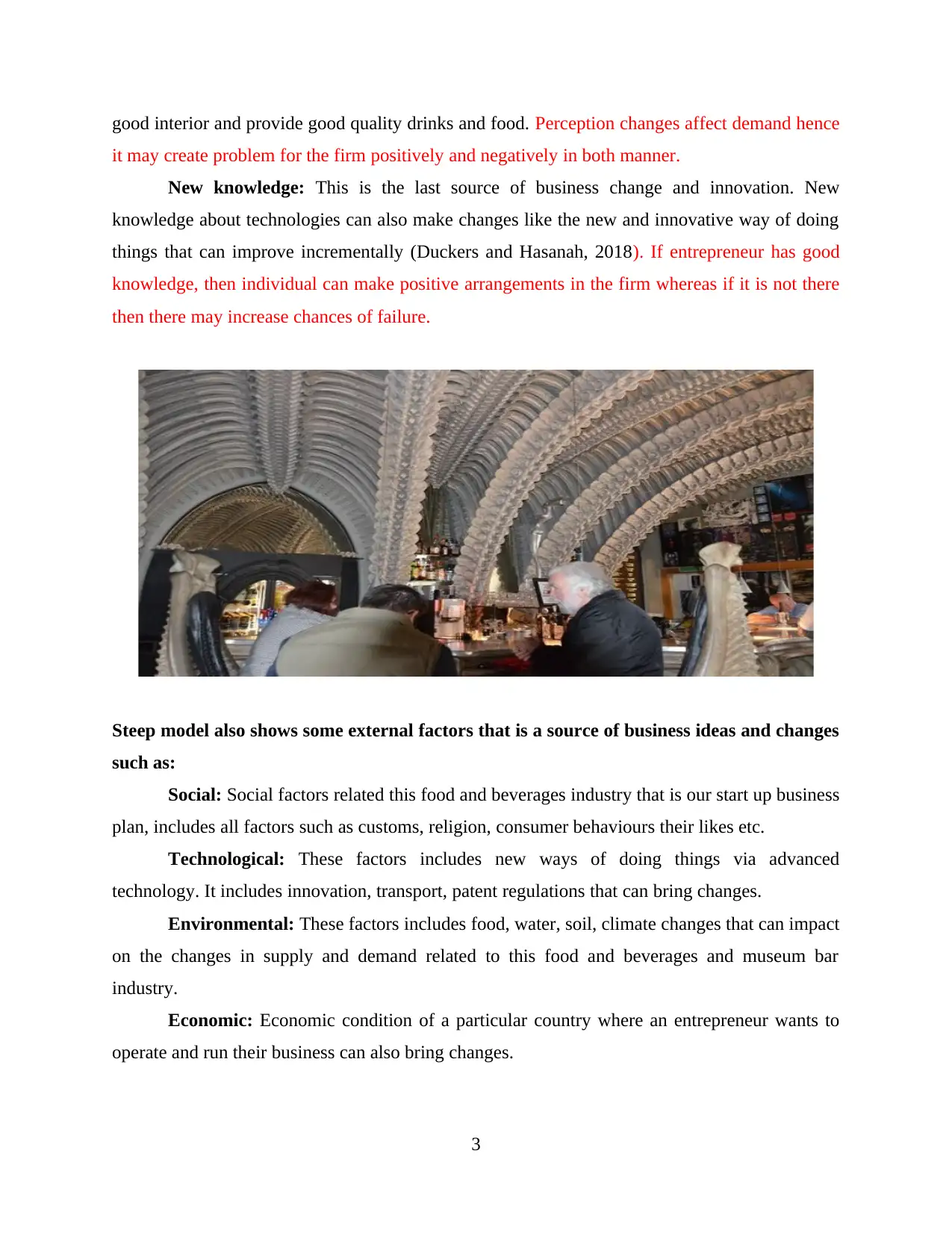
good interior and provide good quality drinks and food. Perception changes affect demand hence
it may create problem for the firm positively and negatively in both manner.
New knowledge: This is the last source of business change and innovation. New
knowledge about technologies can also make changes like the new and innovative way of doing
things that can improve incrementally (Duckers and Hasanah, 2018). If entrepreneur has good
knowledge, then individual can make positive arrangements in the firm whereas if it is not there
then there may increase chances of failure.
Steep model also shows some external factors that is a source of business ideas and changes
such as:
Social: Social factors related this food and beverages industry that is our start up business
plan, includes all factors such as customs, religion, consumer behaviours their likes etc.
Technological: These factors includes new ways of doing things via advanced
technology. It includes innovation, transport, patent regulations that can bring changes.
Environmental: These factors includes food, water, soil, climate changes that can impact
on the changes in supply and demand related to this food and beverages and museum bar
industry.
Economic: Economic condition of a particular country where an entrepreneur wants to
operate and run their business can also bring changes.
3
it may create problem for the firm positively and negatively in both manner.
New knowledge: This is the last source of business change and innovation. New
knowledge about technologies can also make changes like the new and innovative way of doing
things that can improve incrementally (Duckers and Hasanah, 2018). If entrepreneur has good
knowledge, then individual can make positive arrangements in the firm whereas if it is not there
then there may increase chances of failure.
Steep model also shows some external factors that is a source of business ideas and changes
such as:
Social: Social factors related this food and beverages industry that is our start up business
plan, includes all factors such as customs, religion, consumer behaviours their likes etc.
Technological: These factors includes new ways of doing things via advanced
technology. It includes innovation, transport, patent regulations that can bring changes.
Environmental: These factors includes food, water, soil, climate changes that can impact
on the changes in supply and demand related to this food and beverages and museum bar
industry.
Economic: Economic condition of a particular country where an entrepreneur wants to
operate and run their business can also bring changes.
3
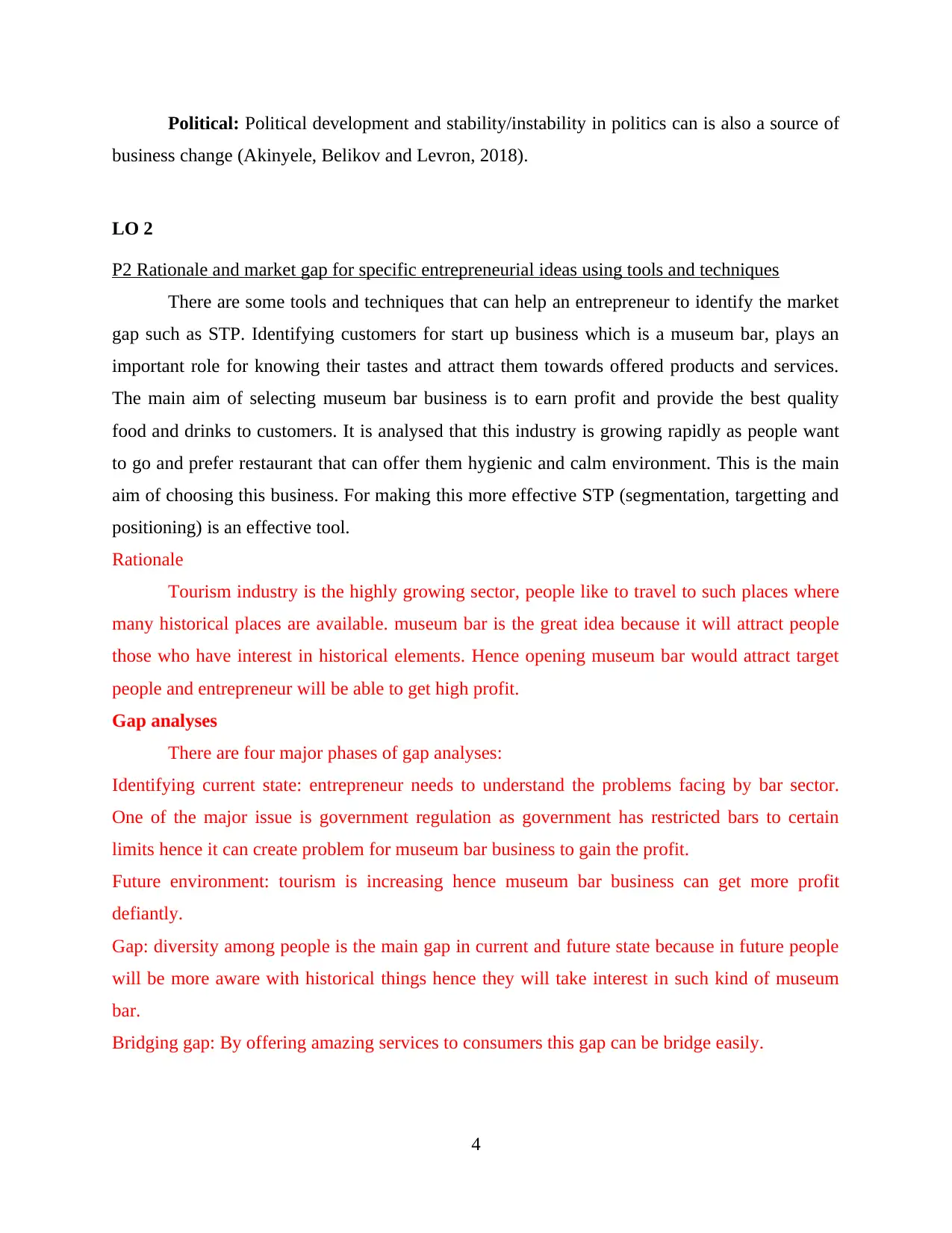
Political: Political development and stability/instability in politics can is also a source of
business change (Akinyele, Belikov and Levron, 2018).
LO 2
P2 Rationale and market gap for specific entrepreneurial ideas using tools and techniques
There are some tools and techniques that can help an entrepreneur to identify the market
gap such as STP. Identifying customers for start up business which is a museum bar, plays an
important role for knowing their tastes and attract them towards offered products and services.
The main aim of selecting museum bar business is to earn profit and provide the best quality
food and drinks to customers. It is analysed that this industry is growing rapidly as people want
to go and prefer restaurant that can offer them hygienic and calm environment. This is the main
aim of choosing this business. For making this more effective STP (segmentation, targetting and
positioning) is an effective tool.
Rationale
Tourism industry is the highly growing sector, people like to travel to such places where
many historical places are available. museum bar is the great idea because it will attract people
those who have interest in historical elements. Hence opening museum bar would attract target
people and entrepreneur will be able to get high profit.
Gap analyses
There are four major phases of gap analyses:
Identifying current state: entrepreneur needs to understand the problems facing by bar sector.
One of the major issue is government regulation as government has restricted bars to certain
limits hence it can create problem for museum bar business to gain the profit.
Future environment: tourism is increasing hence museum bar business can get more profit
defiantly.
Gap: diversity among people is the main gap in current and future state because in future people
will be more aware with historical things hence they will take interest in such kind of museum
bar.
Bridging gap: By offering amazing services to consumers this gap can be bridge easily.
4
business change (Akinyele, Belikov and Levron, 2018).
LO 2
P2 Rationale and market gap for specific entrepreneurial ideas using tools and techniques
There are some tools and techniques that can help an entrepreneur to identify the market
gap such as STP. Identifying customers for start up business which is a museum bar, plays an
important role for knowing their tastes and attract them towards offered products and services.
The main aim of selecting museum bar business is to earn profit and provide the best quality
food and drinks to customers. It is analysed that this industry is growing rapidly as people want
to go and prefer restaurant that can offer them hygienic and calm environment. This is the main
aim of choosing this business. For making this more effective STP (segmentation, targetting and
positioning) is an effective tool.
Rationale
Tourism industry is the highly growing sector, people like to travel to such places where
many historical places are available. museum bar is the great idea because it will attract people
those who have interest in historical elements. Hence opening museum bar would attract target
people and entrepreneur will be able to get high profit.
Gap analyses
There are four major phases of gap analyses:
Identifying current state: entrepreneur needs to understand the problems facing by bar sector.
One of the major issue is government regulation as government has restricted bars to certain
limits hence it can create problem for museum bar business to gain the profit.
Future environment: tourism is increasing hence museum bar business can get more profit
defiantly.
Gap: diversity among people is the main gap in current and future state because in future people
will be more aware with historical things hence they will take interest in such kind of museum
bar.
Bridging gap: By offering amazing services to consumers this gap can be bridge easily.
4
⊘ This is a preview!⊘
Do you want full access?
Subscribe today to unlock all pages.

Trusted by 1+ million students worldwide
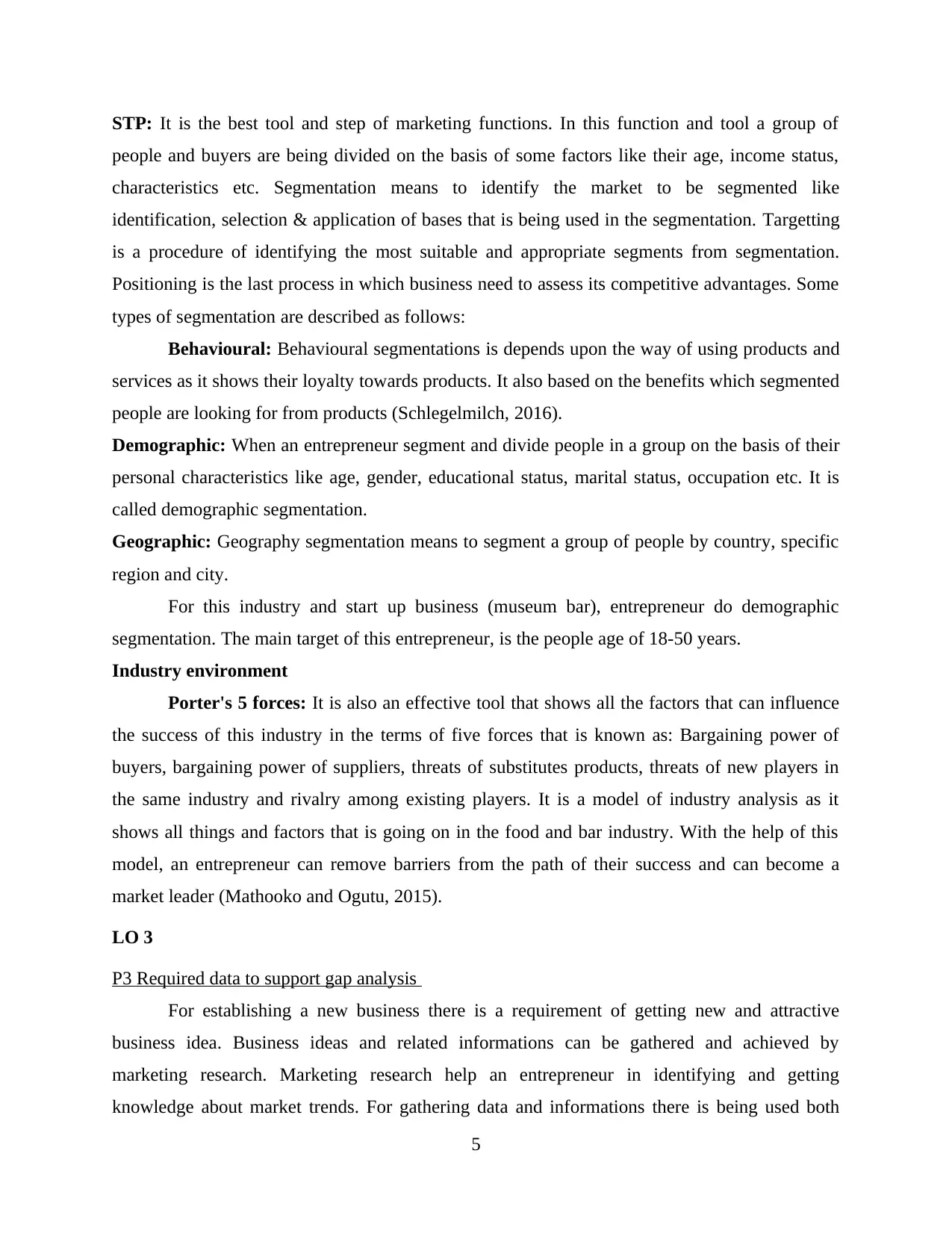
STP: It is the best tool and step of marketing functions. In this function and tool a group of
people and buyers are being divided on the basis of some factors like their age, income status,
characteristics etc. Segmentation means to identify the market to be segmented like
identification, selection & application of bases that is being used in the segmentation. Targetting
is a procedure of identifying the most suitable and appropriate segments from segmentation.
Positioning is the last process in which business need to assess its competitive advantages. Some
types of segmentation are described as follows:
Behavioural: Behavioural segmentations is depends upon the way of using products and
services as it shows their loyalty towards products. It also based on the benefits which segmented
people are looking for from products (Schlegelmilch, 2016).
Demographic: When an entrepreneur segment and divide people in a group on the basis of their
personal characteristics like age, gender, educational status, marital status, occupation etc. It is
called demographic segmentation.
Geographic: Geography segmentation means to segment a group of people by country, specific
region and city.
For this industry and start up business (museum bar), entrepreneur do demographic
segmentation. The main target of this entrepreneur, is the people age of 18-50 years.
Industry environment
Porter's 5 forces: It is also an effective tool that shows all the factors that can influence
the success of this industry in the terms of five forces that is known as: Bargaining power of
buyers, bargaining power of suppliers, threats of substitutes products, threats of new players in
the same industry and rivalry among existing players. It is a model of industry analysis as it
shows all things and factors that is going on in the food and bar industry. With the help of this
model, an entrepreneur can remove barriers from the path of their success and can become a
market leader (Mathooko and Ogutu, 2015).
LO 3
P3 Required data to support gap analysis
For establishing a new business there is a requirement of getting new and attractive
business idea. Business ideas and related informations can be gathered and achieved by
marketing research. Marketing research help an entrepreneur in identifying and getting
knowledge about market trends. For gathering data and informations there is being used both
5
people and buyers are being divided on the basis of some factors like their age, income status,
characteristics etc. Segmentation means to identify the market to be segmented like
identification, selection & application of bases that is being used in the segmentation. Targetting
is a procedure of identifying the most suitable and appropriate segments from segmentation.
Positioning is the last process in which business need to assess its competitive advantages. Some
types of segmentation are described as follows:
Behavioural: Behavioural segmentations is depends upon the way of using products and
services as it shows their loyalty towards products. It also based on the benefits which segmented
people are looking for from products (Schlegelmilch, 2016).
Demographic: When an entrepreneur segment and divide people in a group on the basis of their
personal characteristics like age, gender, educational status, marital status, occupation etc. It is
called demographic segmentation.
Geographic: Geography segmentation means to segment a group of people by country, specific
region and city.
For this industry and start up business (museum bar), entrepreneur do demographic
segmentation. The main target of this entrepreneur, is the people age of 18-50 years.
Industry environment
Porter's 5 forces: It is also an effective tool that shows all the factors that can influence
the success of this industry in the terms of five forces that is known as: Bargaining power of
buyers, bargaining power of suppliers, threats of substitutes products, threats of new players in
the same industry and rivalry among existing players. It is a model of industry analysis as it
shows all things and factors that is going on in the food and bar industry. With the help of this
model, an entrepreneur can remove barriers from the path of their success and can become a
market leader (Mathooko and Ogutu, 2015).
LO 3
P3 Required data to support gap analysis
For establishing a new business there is a requirement of getting new and attractive
business idea. Business ideas and related informations can be gathered and achieved by
marketing research. Marketing research help an entrepreneur in identifying and getting
knowledge about market trends. For gathering data and informations there is being used both
5
Paraphrase This Document
Need a fresh take? Get an instant paraphrase of this document with our AI Paraphraser
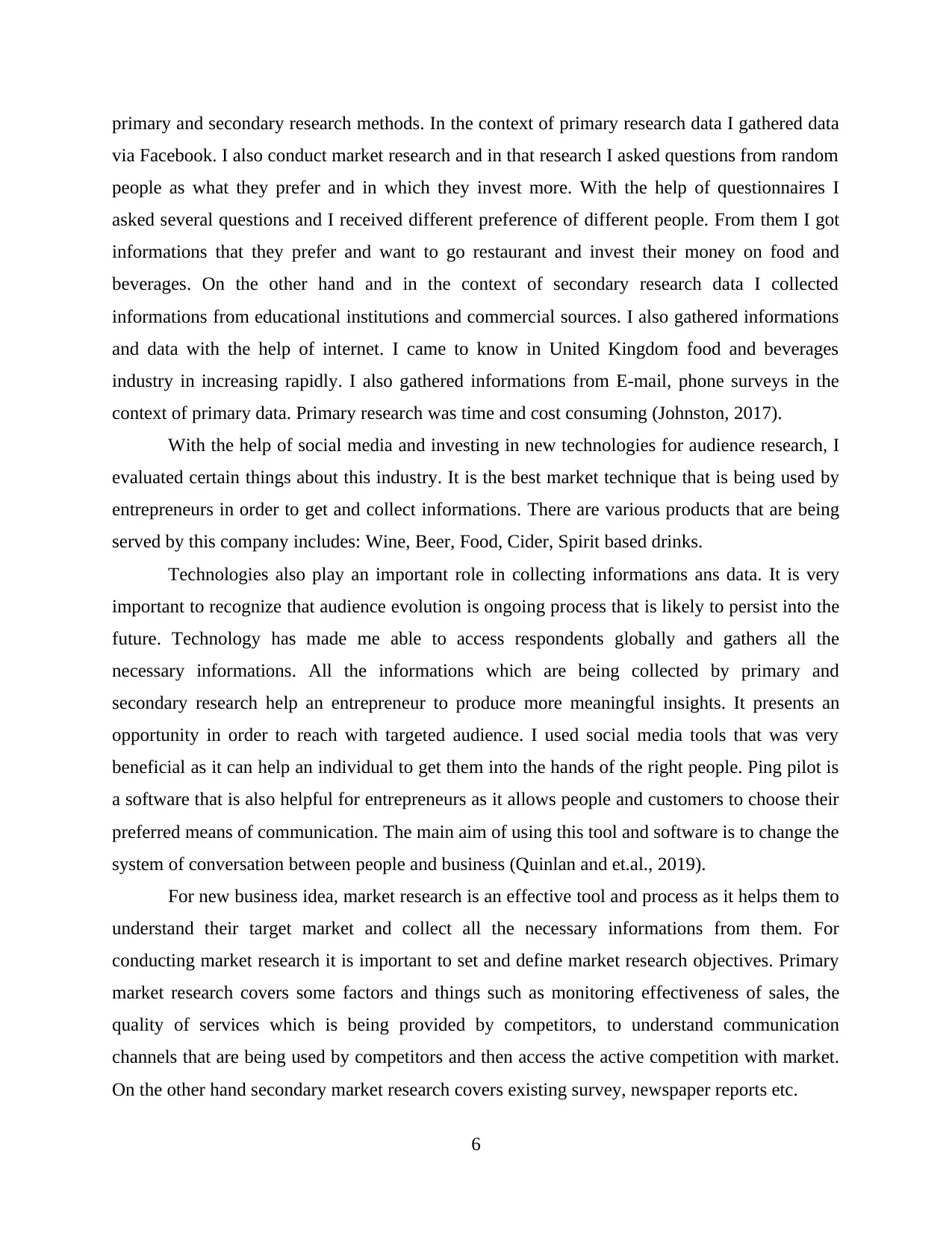
primary and secondary research methods. In the context of primary research data I gathered data
via Facebook. I also conduct market research and in that research I asked questions from random
people as what they prefer and in which they invest more. With the help of questionnaires I
asked several questions and I received different preference of different people. From them I got
informations that they prefer and want to go restaurant and invest their money on food and
beverages. On the other hand and in the context of secondary research data I collected
informations from educational institutions and commercial sources. I also gathered informations
and data with the help of internet. I came to know in United Kingdom food and beverages
industry in increasing rapidly. I also gathered informations from E-mail, phone surveys in the
context of primary data. Primary research was time and cost consuming (Johnston, 2017).
With the help of social media and investing in new technologies for audience research, I
evaluated certain things about this industry. It is the best market technique that is being used by
entrepreneurs in order to get and collect informations. There are various products that are being
served by this company includes: Wine, Beer, Food, Cider, Spirit based drinks.
Technologies also play an important role in collecting informations ans data. It is very
important to recognize that audience evolution is ongoing process that is likely to persist into the
future. Technology has made me able to access respondents globally and gathers all the
necessary informations. All the informations which are being collected by primary and
secondary research help an entrepreneur to produce more meaningful insights. It presents an
opportunity in order to reach with targeted audience. I used social media tools that was very
beneficial as it can help an individual to get them into the hands of the right people. Ping pilot is
a software that is also helpful for entrepreneurs as it allows people and customers to choose their
preferred means of communication. The main aim of using this tool and software is to change the
system of conversation between people and business (Quinlan and et.al., 2019).
For new business idea, market research is an effective tool and process as it helps them to
understand their target market and collect all the necessary informations from them. For
conducting market research it is important to set and define market research objectives. Primary
market research covers some factors and things such as monitoring effectiveness of sales, the
quality of services which is being provided by competitors, to understand communication
channels that are being used by competitors and then access the active competition with market.
On the other hand secondary market research covers existing survey, newspaper reports etc.
6
via Facebook. I also conduct market research and in that research I asked questions from random
people as what they prefer and in which they invest more. With the help of questionnaires I
asked several questions and I received different preference of different people. From them I got
informations that they prefer and want to go restaurant and invest their money on food and
beverages. On the other hand and in the context of secondary research data I collected
informations from educational institutions and commercial sources. I also gathered informations
and data with the help of internet. I came to know in United Kingdom food and beverages
industry in increasing rapidly. I also gathered informations from E-mail, phone surveys in the
context of primary data. Primary research was time and cost consuming (Johnston, 2017).
With the help of social media and investing in new technologies for audience research, I
evaluated certain things about this industry. It is the best market technique that is being used by
entrepreneurs in order to get and collect informations. There are various products that are being
served by this company includes: Wine, Beer, Food, Cider, Spirit based drinks.
Technologies also play an important role in collecting informations ans data. It is very
important to recognize that audience evolution is ongoing process that is likely to persist into the
future. Technology has made me able to access respondents globally and gathers all the
necessary informations. All the informations which are being collected by primary and
secondary research help an entrepreneur to produce more meaningful insights. It presents an
opportunity in order to reach with targeted audience. I used social media tools that was very
beneficial as it can help an individual to get them into the hands of the right people. Ping pilot is
a software that is also helpful for entrepreneurs as it allows people and customers to choose their
preferred means of communication. The main aim of using this tool and software is to change the
system of conversation between people and business (Quinlan and et.al., 2019).
For new business idea, market research is an effective tool and process as it helps them to
understand their target market and collect all the necessary informations from them. For
conducting market research it is important to set and define market research objectives. Primary
market research covers some factors and things such as monitoring effectiveness of sales, the
quality of services which is being provided by competitors, to understand communication
channels that are being used by competitors and then access the active competition with market.
On the other hand secondary market research covers existing survey, newspaper reports etc.
6
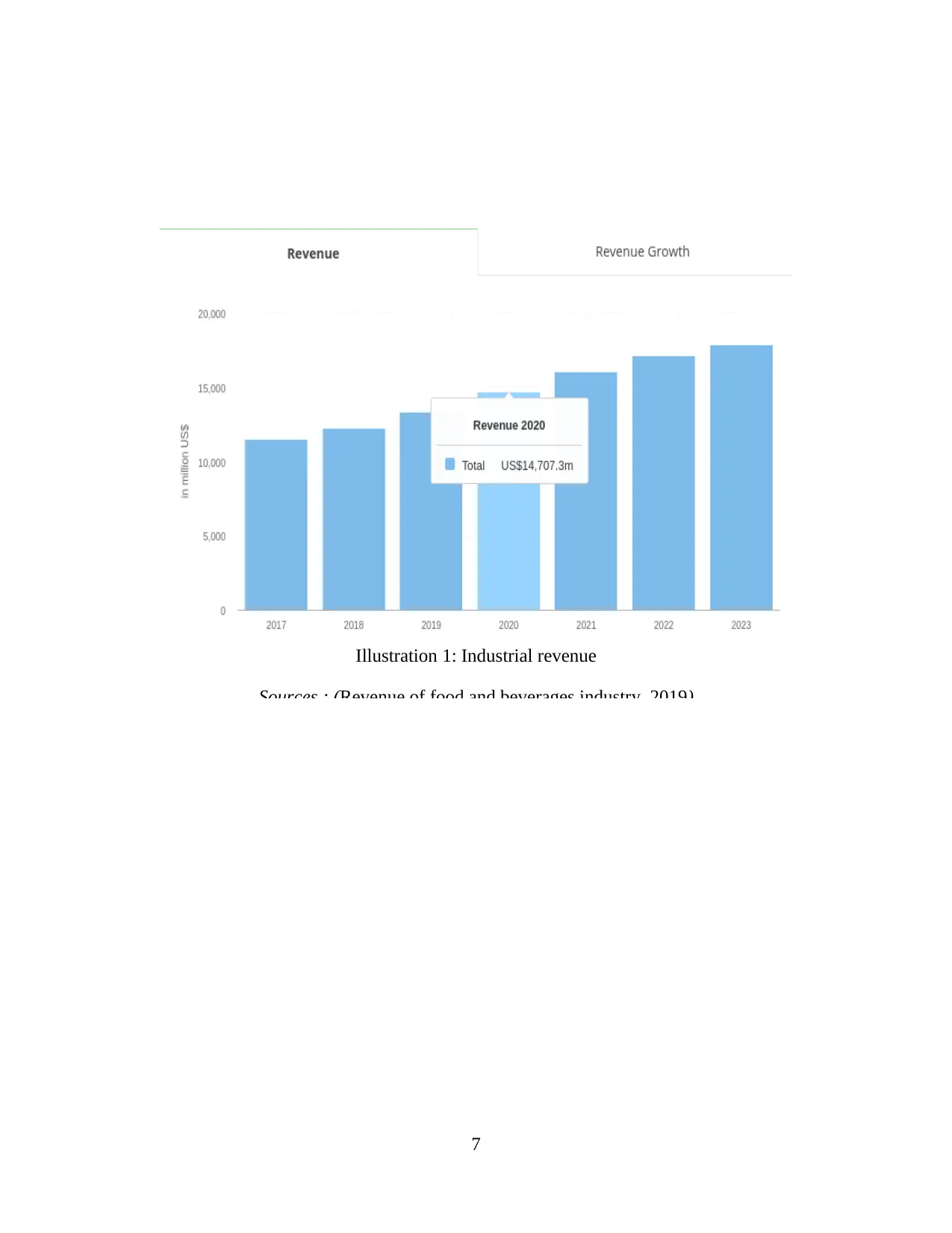
7
Illustration 1: Industrial revenue
Sources : (Revenue of food and beverages industry, 2019)
Illustration 1: Industrial revenue
Sources : (Revenue of food and beverages industry, 2019)
⊘ This is a preview!⊘
Do you want full access?
Subscribe today to unlock all pages.

Trusted by 1+ million students worldwide
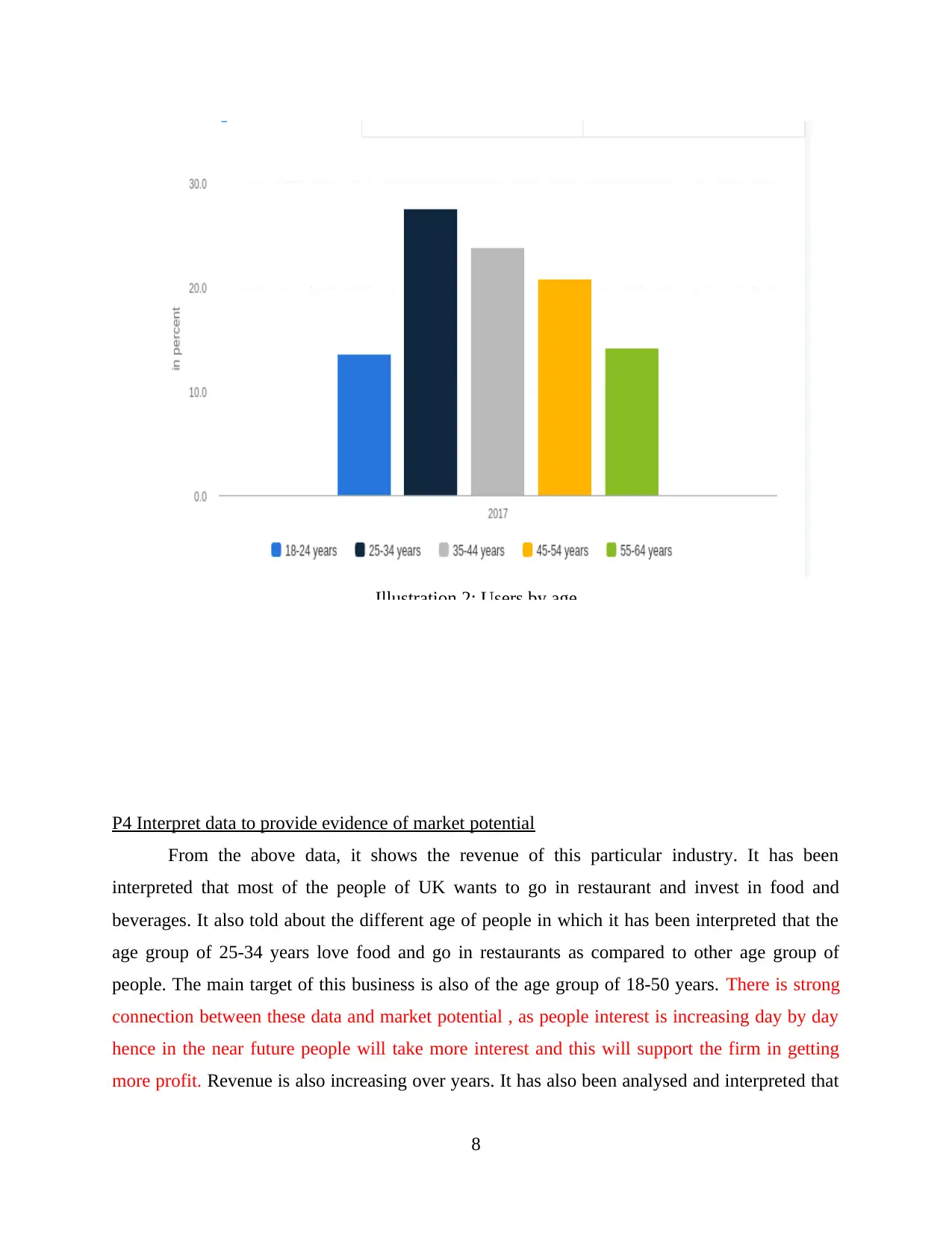
P4 Interpret data to provide evidence of market potential
From the above data, it shows the revenue of this particular industry. It has been
interpreted that most of the people of UK wants to go in restaurant and invest in food and
beverages. It also told about the different age of people in which it has been interpreted that the
age group of 25-34 years love food and go in restaurants as compared to other age group of
people. The main target of this business is also of the age group of 18-50 years. There is strong
connection between these data and market potential , as people interest is increasing day by day
hence in the near future people will take more interest and this will support the firm in getting
more profit. Revenue is also increasing over years. It has also been analysed and interpreted that
8
Illustration 2: Users by age
From the above data, it shows the revenue of this particular industry. It has been
interpreted that most of the people of UK wants to go in restaurant and invest in food and
beverages. It also told about the different age of people in which it has been interpreted that the
age group of 25-34 years love food and go in restaurants as compared to other age group of
people. The main target of this business is also of the age group of 18-50 years. There is strong
connection between these data and market potential , as people interest is increasing day by day
hence in the near future people will take more interest and this will support the firm in getting
more profit. Revenue is also increasing over years. It has also been analysed and interpreted that
8
Illustration 2: Users by age
Paraphrase This Document
Need a fresh take? Get an instant paraphrase of this document with our AI Paraphraser
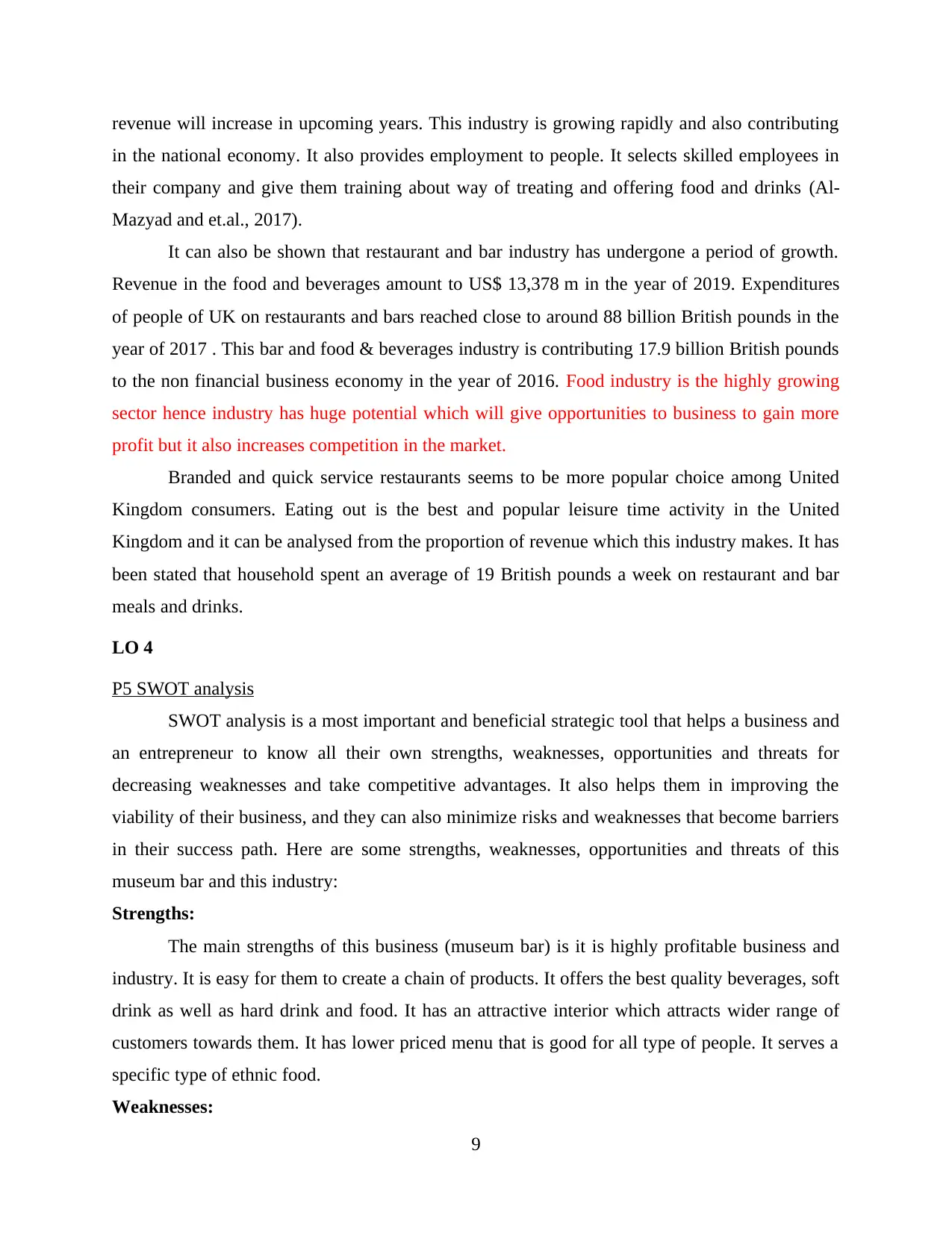
revenue will increase in upcoming years. This industry is growing rapidly and also contributing
in the national economy. It also provides employment to people. It selects skilled employees in
their company and give them training about way of treating and offering food and drinks (Al-
Mazyad and et.al., 2017).
It can also be shown that restaurant and bar industry has undergone a period of growth.
Revenue in the food and beverages amount to US$ 13,378 m in the year of 2019. Expenditures
of people of UK on restaurants and bars reached close to around 88 billion British pounds in the
year of 2017 . This bar and food & beverages industry is contributing 17.9 billion British pounds
to the non financial business economy in the year of 2016. Food industry is the highly growing
sector hence industry has huge potential which will give opportunities to business to gain more
profit but it also increases competition in the market.
Branded and quick service restaurants seems to be more popular choice among United
Kingdom consumers. Eating out is the best and popular leisure time activity in the United
Kingdom and it can be analysed from the proportion of revenue which this industry makes. It has
been stated that household spent an average of 19 British pounds a week on restaurant and bar
meals and drinks.
LO 4
P5 SWOT analysis
SWOT analysis is a most important and beneficial strategic tool that helps a business and
an entrepreneur to know all their own strengths, weaknesses, opportunities and threats for
decreasing weaknesses and take competitive advantages. It also helps them in improving the
viability of their business, and they can also minimize risks and weaknesses that become barriers
in their success path. Here are some strengths, weaknesses, opportunities and threats of this
museum bar and this industry:
Strengths:
The main strengths of this business (museum bar) is it is highly profitable business and
industry. It is easy for them to create a chain of products. It offers the best quality beverages, soft
drink as well as hard drink and food. It has an attractive interior which attracts wider range of
customers towards them. It has lower priced menu that is good for all type of people. It serves a
specific type of ethnic food.
Weaknesses:
9
in the national economy. It also provides employment to people. It selects skilled employees in
their company and give them training about way of treating and offering food and drinks (Al-
Mazyad and et.al., 2017).
It can also be shown that restaurant and bar industry has undergone a period of growth.
Revenue in the food and beverages amount to US$ 13,378 m in the year of 2019. Expenditures
of people of UK on restaurants and bars reached close to around 88 billion British pounds in the
year of 2017 . This bar and food & beverages industry is contributing 17.9 billion British pounds
to the non financial business economy in the year of 2016. Food industry is the highly growing
sector hence industry has huge potential which will give opportunities to business to gain more
profit but it also increases competition in the market.
Branded and quick service restaurants seems to be more popular choice among United
Kingdom consumers. Eating out is the best and popular leisure time activity in the United
Kingdom and it can be analysed from the proportion of revenue which this industry makes. It has
been stated that household spent an average of 19 British pounds a week on restaurant and bar
meals and drinks.
LO 4
P5 SWOT analysis
SWOT analysis is a most important and beneficial strategic tool that helps a business and
an entrepreneur to know all their own strengths, weaknesses, opportunities and threats for
decreasing weaknesses and take competitive advantages. It also helps them in improving the
viability of their business, and they can also minimize risks and weaknesses that become barriers
in their success path. Here are some strengths, weaknesses, opportunities and threats of this
museum bar and this industry:
Strengths:
The main strengths of this business (museum bar) is it is highly profitable business and
industry. It is easy for them to create a chain of products. It offers the best quality beverages, soft
drink as well as hard drink and food. It has an attractive interior which attracts wider range of
customers towards them. It has lower priced menu that is good for all type of people. It serves a
specific type of ethnic food.
Weaknesses:
9
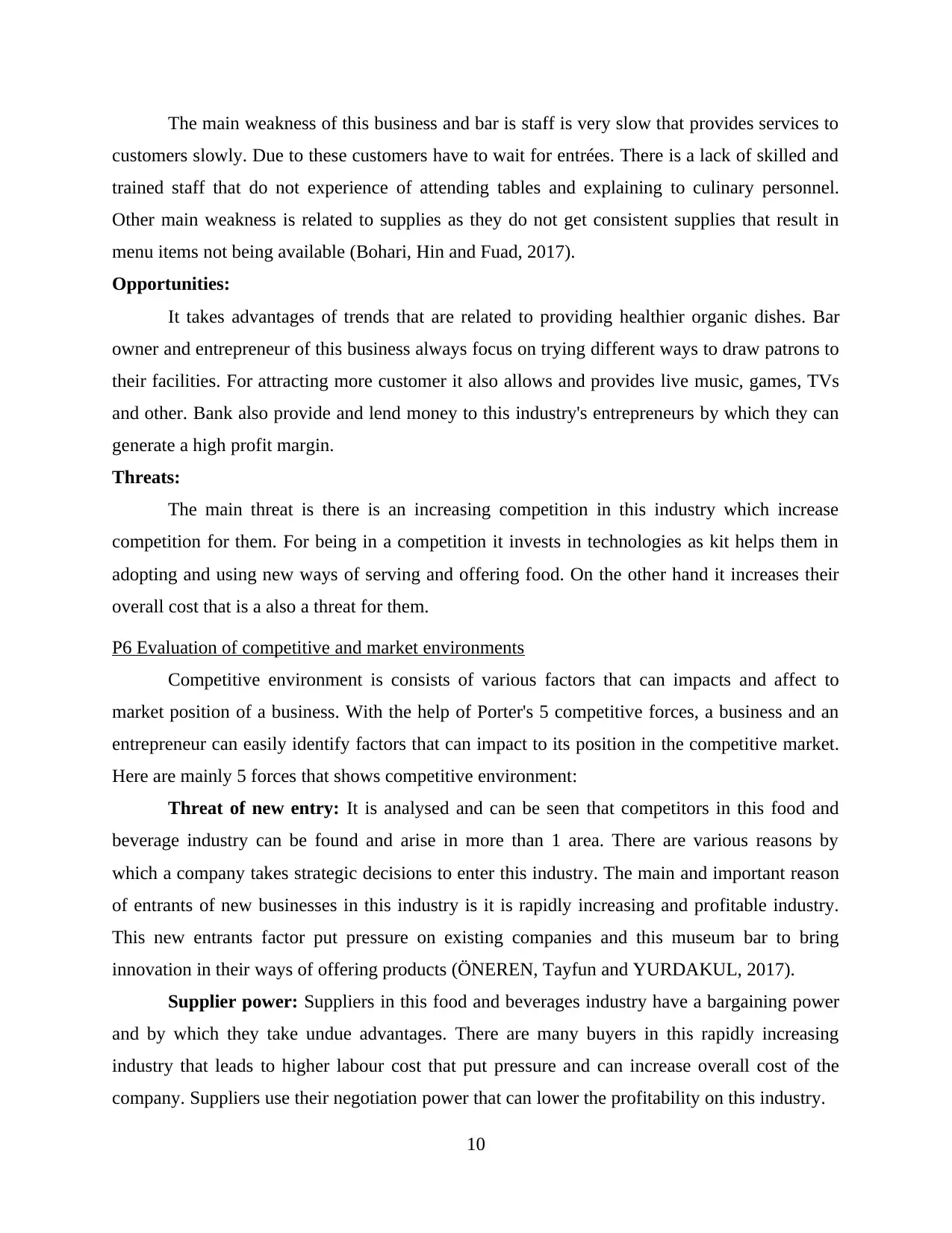
The main weakness of this business and bar is staff is very slow that provides services to
customers slowly. Due to these customers have to wait for entrées. There is a lack of skilled and
trained staff that do not experience of attending tables and explaining to culinary personnel.
Other main weakness is related to supplies as they do not get consistent supplies that result in
menu items not being available (Bohari, Hin and Fuad, 2017).
Opportunities:
It takes advantages of trends that are related to providing healthier organic dishes. Bar
owner and entrepreneur of this business always focus on trying different ways to draw patrons to
their facilities. For attracting more customer it also allows and provides live music, games, TVs
and other. Bank also provide and lend money to this industry's entrepreneurs by which they can
generate a high profit margin.
Threats:
The main threat is there is an increasing competition in this industry which increase
competition for them. For being in a competition it invests in technologies as kit helps them in
adopting and using new ways of serving and offering food. On the other hand it increases their
overall cost that is a also a threat for them.
P6 Evaluation of competitive and market environments
Competitive environment is consists of various factors that can impacts and affect to
market position of a business. With the help of Porter's 5 competitive forces, a business and an
entrepreneur can easily identify factors that can impact to its position in the competitive market.
Here are mainly 5 forces that shows competitive environment:
Threat of new entry: It is analysed and can be seen that competitors in this food and
beverage industry can be found and arise in more than 1 area. There are various reasons by
which a company takes strategic decisions to enter this industry. The main and important reason
of entrants of new businesses in this industry is it is rapidly increasing and profitable industry.
This new entrants factor put pressure on existing companies and this museum bar to bring
innovation in their ways of offering products (ÖNEREN, Tayfun and YURDAKUL, 2017).
Supplier power: Suppliers in this food and beverages industry have a bargaining power
and by which they take undue advantages. There are many buyers in this rapidly increasing
industry that leads to higher labour cost that put pressure and can increase overall cost of the
company. Suppliers use their negotiation power that can lower the profitability on this industry.
10
customers slowly. Due to these customers have to wait for entrées. There is a lack of skilled and
trained staff that do not experience of attending tables and explaining to culinary personnel.
Other main weakness is related to supplies as they do not get consistent supplies that result in
menu items not being available (Bohari, Hin and Fuad, 2017).
Opportunities:
It takes advantages of trends that are related to providing healthier organic dishes. Bar
owner and entrepreneur of this business always focus on trying different ways to draw patrons to
their facilities. For attracting more customer it also allows and provides live music, games, TVs
and other. Bank also provide and lend money to this industry's entrepreneurs by which they can
generate a high profit margin.
Threats:
The main threat is there is an increasing competition in this industry which increase
competition for them. For being in a competition it invests in technologies as kit helps them in
adopting and using new ways of serving and offering food. On the other hand it increases their
overall cost that is a also a threat for them.
P6 Evaluation of competitive and market environments
Competitive environment is consists of various factors that can impacts and affect to
market position of a business. With the help of Porter's 5 competitive forces, a business and an
entrepreneur can easily identify factors that can impact to its position in the competitive market.
Here are mainly 5 forces that shows competitive environment:
Threat of new entry: It is analysed and can be seen that competitors in this food and
beverage industry can be found and arise in more than 1 area. There are various reasons by
which a company takes strategic decisions to enter this industry. The main and important reason
of entrants of new businesses in this industry is it is rapidly increasing and profitable industry.
This new entrants factor put pressure on existing companies and this museum bar to bring
innovation in their ways of offering products (ÖNEREN, Tayfun and YURDAKUL, 2017).
Supplier power: Suppliers in this food and beverages industry have a bargaining power
and by which they take undue advantages. There are many buyers in this rapidly increasing
industry that leads to higher labour cost that put pressure and can increase overall cost of the
company. Suppliers use their negotiation power that can lower the profitability on this industry.
10
⊘ This is a preview!⊘
Do you want full access?
Subscribe today to unlock all pages.

Trusted by 1+ million students worldwide
1 out of 15
Related Documents
Your All-in-One AI-Powered Toolkit for Academic Success.
+13062052269
info@desklib.com
Available 24*7 on WhatsApp / Email
![[object Object]](/_next/static/media/star-bottom.7253800d.svg)
Unlock your academic potential
Copyright © 2020–2025 A2Z Services. All Rights Reserved. Developed and managed by ZUCOL.





